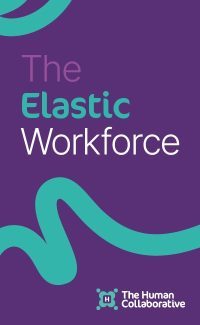If the last three years have taught us anything, it’s that business resilience relies on the capability and capacity of people.
It has also raised the question in many organisations: ‘How do I know what my whole workforce is?’. Having visibility across all people in a business is needed and expected these days. Most businesses have visibility of their employees, but very few have the same visibility with their contingent workers.
At The Human Collaborative, our conversations with Australian businesses are changing. We are increasingly working with our clients to help them identify strategies and approaches to help them maintain their market presence and continue their strategic direction by having complete visibility of, and access to, their workforce. This means a deeper dive into the holistic capabilities of their existing workforce and alternative options; the “elastic” nature of a workforce.
What is the Elastic Workforce?
The Elastic Workforce is often an invisible segment of a workforce – collectively referred to as contingent workers. They are the people and skills that represent the most significant opportunity for your business to flex, fill gaps and accumulate new skills for a long or short time. Additionally, they are elastic to your business needs; they are the resources that present flexibility, can work outside of standard working hours, and allow access to expertise without needing additional headcount – a fixed cost.
The sourcing and management of this underutilised talent pool need a strategy. If left unchecked or if the benefit of this workforce needs to be understood, it can present business challenges such as untracked skills and spending, multiple vendors and little benefit to your business other than plugging a temporary gap.
It may seem complex, but it doesn’t need to be. We find that what benefits clients is a clear understanding and utilisation of this skill-rich and flexible group of workers. We all know it’s a clear competitive advantage for any business to be agile in today’s climate.
The Benefits
The ability to flex your business up and down when needed. Moreover, the Elastic Workforce’s capability extends far beyond the traditional containments of a contingent workforce:
Capacity
Existing and directly employed workforces often align with requirements that enable the current business-as-usual approach and may have rigidity constraints. When it comes to the capacity of your existing workforce, creating elasticity means you can bolster your current workforce in the places you need. This could be on a cyclical basis specific to match your business or market, the need to drive a project, insert capability and capacity, or when your business is presented with new challenges or opportunities.
The Elastic Workforce provides quick access to the necessary skills you need. Enabling a specific strategy will deliver true flow and agility to your business in a highly competitive landscape. Also, with technology enabling the workforce, the Elastic Workforce’s access to and time to productivity is fast! The lack of the right processes and systems usually slows things down or creates risks.
When we work with our clients to assess their workforce needs, this is the number one reason for defining a strategy for contingent or contract workers – they need a quick response to a business need. However, if we look ahead to leverage this cohort truly, more capability and benefits can be drawn into your business.
Capability
From a time and skills perspective, flexing your permanent workforce can be challenging. Training, new technology, and alternative business structures all take time and effort, which may not be a luxury that you have. Additionally, the rapid pace of change in technology and skills means that the right talent may be scarce in the market for permanent, but this is only sometimes the case with contingent. Permanent workers are often tied to traditional working methods and working days. For example, the Elastic Workforce can provide a “chasing the sun” approach if there is a business need for speed.
Different generations and life choices also support non-traditional ways of working. Think about it, if you’re a cyber security specialist who likes to travel Australia in a caravan but flexibly work from anywhere, wouldn’t you? This is a positive for businesses and something we need to embrace. These highly skilled professionals can also fill your skills gap while meeting their needs. They can work in a shift-like approach, enabling you to deliver on a project sooner rather than later.
In our experience, the benefits of utilising the Elastic Workforce to supplement capability is a purposeful way of joining the dots between challenging market conditions and the power of maintaining your enterprise-focused strategy. They are readily available, have the required demonstrated capability, are often looking for flexibility, and are an enormous pool of supplemental talent. When competition is a critical way we do business, isn’t doing this better than your competitors a distinct advantage?
The Importance of Technology
Tracking performance, skills, costs, and quality are all equally important – and in today’s world, so is the ease of use of technology. Technology will enable your business to access the Elastic Workforce, allow quick visibility of available talent and streamline the process of engaging non-employees into roles within your company.
When we engage with businesses, large and small, we know that one size does not suit all with technology. The critical part is asking the right questions and defining the scope and needs to incorporate your business drivers into any technology choice.
What should business leaders be doing?
 Every day we are reading and hearing more and more conversations asking leading businesses to think outside of the box of their existing workforce models. There is an absolute need to elevate conversations around contingent workers and the opportunity they provide to a business.
Every day we are reading and hearing more and more conversations asking leading businesses to think outside of the box of their existing workforce models. There is an absolute need to elevate conversations around contingent workers and the opportunity they provide to a business.
We at The Human Collaborative are on a mission to support businesses with their journey of designing and mobilising their Elastic Workforce strategies. Check out our website for more details on our Elastic Workforce Series, which kicked off this month, where we interviewed Alissa Patoulios about the Optus Australia Contractor Central strategy and have two more sessions planned with companies who are taking a strategic approach to the Elastic Workforce.






